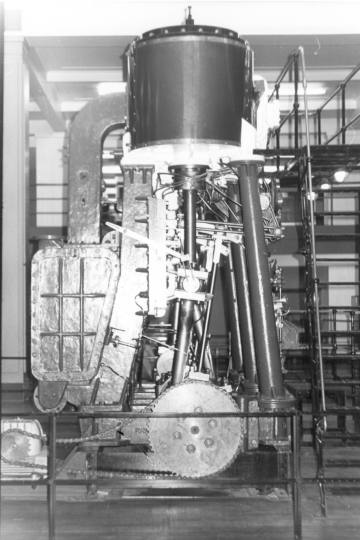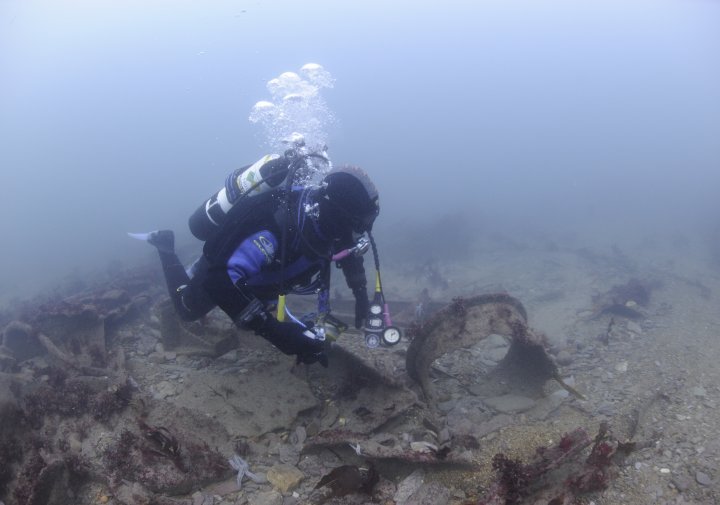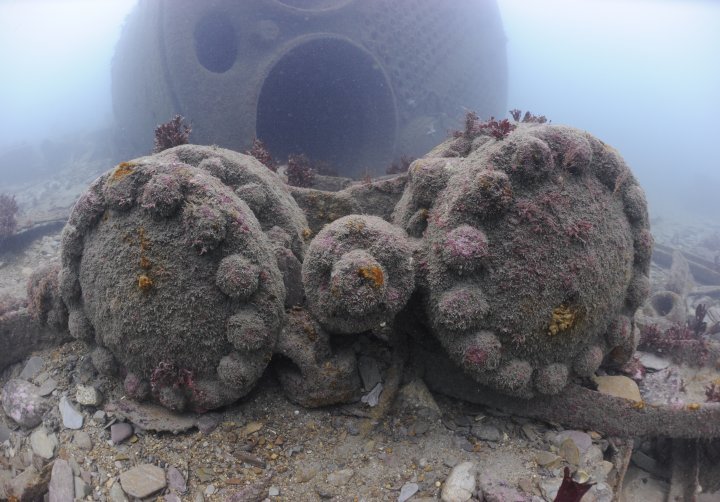Most ships get wrecked in tragic or unfortunate circumstances. Often they sink in mountainous seas, or get pounded to pieces on some treacherous shore during a howling gale. The sinking of the Glen Strathallan however, couldn’t be more different, as she was deliberately sunk during a flat calm, to honour the wishes of her dead owner.
In 1928 the shipbuilding firm of Cochrance and Sons of Selby, Yorkshire, won a contract to build a steam trawler of 690 tons displacement. She was to be 150 feet long by 24 feet beam, have a speed of ten knots, and generally be one of the most modern and efficient vessels of her day. Unfortunately before she was finished, the firm that had ordered her went bankrupt and for a while things looked pretty bleak. However the millionaire Colby Cubbin, who knew a bargain when he saw it, snapped up the unfinished vessel, had her converted to a pleasure yacht, and gave her the name Glen Strathallan.

At the outbreak of the Second World War, the Glen Strathallan was lent to the Royal Navy and refitted as an escort vessel, a duty she carried out for nearly four years. When the War was over, Colby Cubbin got his yacht returned to him, and he used it extensively for cruising between the Isle of Man and Scotland. He must have become very fond of her, because when he unexpectedly died his Will revealed that he wished the Glen Strathallan to be used as a floating school room. But he also stipulated that if no useful employment could be found for his ship, she was to be taken out to sea and sunk.
For years the Glen Strathallan was used as a training ship for future officers of the Merchant Navy, but finally her age and escalating costs made her an uneconomic proposition. Faithful to the wishes of the late owner, the trustees decided to sink the Strathallan in the Hurd Deep, way out in the English Channel. Plymouth Ocean Projects of Fort Bovisand got wind of the project, and appealed to the trustees to sink the ship near the entrance to Plymouth Sound instead. Here they said the ship could be used as an underwater classroom and so still be of some educational value. This scheme was agreed to, and after taking out the Strathallan’s steam engine, (which is now on view at the Science Museum, London) her seacocks were removed, and on 27 April 1970 the Glen Strathallan gently slipped beneath the waves about 200 yards from the Shagstone.

A lot of good ideas often go wrong through lack of foresight and this was to be the case with the Glen Strathallan. In the end Trinity House placed a buoy on the wrecksite. However a wrangle blew up about who was responsible for paying for the maintenance of the buoy, and in the end Fort Bovisand was ordered to render the wreck safe to navigation. In due course the Glen Strathallan was dispersed and its value as an underwater classroom destroyed. A great pity, and something I am sure that Colby Cubbin would not have approved of.
The wreck now lies under fifty feet of water on a sandy bottom strewn with large rocky outcrops. Although well dispersed the main parts still make for a fairly compact drive. The bow section is still recognisable, and you can just about follow the outline of the hull by tracing the ribs back towards the rear cabins. Near the cabin lies the main boiler. This is quite massive, standing some twenty feet above the sand, and you can swim partway into it via some large inlet holes. You can also swim into the cabin but it is rather confined, and there is a lot of jagged metal about. Strewn all around this area are parts of the companionways, the rudder, and a section of decking still with its planking and large deck pulleys. Amongst the tumbled iron plating roam some friendly wrasse, the most impressive being a rather large red one with big white spots. He wouldn’t accept our offerings of chopped mackerel, but the rest seemed quite used to it. On the outskirts of the wreck, in amongst the sand and rocks, can still be found the odd fork, a piece of tableware, or some of the tiles used in the toilets and galley. On the way back to the bows, there are still lots of debris for you to sift through including some ladders, a large deck winch, and many other bits and pieces of broken machinery. Around the bows are masses of steel plates, under which lurk lobsters. They are not very big so they are not really worth taking. However, with a bit of patience and bribery they will come out and allow you to take their photograph.

All in all the Glen Strathallan provides some very good diving. The visibility is usually very good, and currents present no problems. The wreck is prominently marked on the latest charts, and because of its close proximity to the Shagstone, it is quite easy to find. The marks shown here should put you directly on the bows. However if any difficulty is experienced I am sure that Fort Bovisand will be pleased to help. They put hundreds of divers on her each year, and with any luck you will be able to team up with a group about to dive on her.

Don’t wait too long to dive on this one. I am sure that Colby Cubbin, wherever he is, would much rather you visit his ship while there is still something of her to see, rather than wait until she breaks up and is scattered all over the seabed.
I dive on this wreck all the time, and although it is now getting a bit scattered, the main features are still there. it is still a nice little wreck with plenty of photo opportunities. These were taken by Peter Rowlands around Feb 2009.




Paul Barry says
I sailed on the Glen Strathallen in 1962 I believe it was. I was at West Norwood Technical College doing my second class and first class PMG certificates. I well remember the Glen Strathallen. She was still coal burning when I was on it and I remember the engineer cadets had to take ‘bunkers’ which meant they had to carry bags of coal from a coal lorry drawn up on the quayside and empty them into the bunkers.
Bob Anderson says
I was on the Glen in 1963. When I was on the Arethusa we spent a week doing sea training on her. I was 13 years old and this was my first time at sea.
Peter Breakspear says
The bell from Glen Strathallan was sold at auction in Wareham, 1/08/11, for £560.00 I didn’t get it but would have loved to.
Roger Crook says
Do you know who got the Bell. The Joint Services Sub aqua Diving Centre still work out of Bovisand and would love to get the bell as the Glen is pretty much the house wreck. Can you help?
David Randle says
Did you know , there is a drinking fountain / bird bath , in the castle grounds in Stornoway donated by the owners of the Glen Strathallan steam ship owners.
William Goad says
I was a Merchant Navy Engineer Cadet training at the Poplar Technical College, Poplar, East London [formerly the London School of Marine Engineering] 1965/67 and part of our engineering training was to service the main and auxiliary machinery on board during the school summer holidays [Engineer Cadets did not get the summer holiday off as we were being paid!]. During our second year we were assigned to join the ship on a Sunday and prepare her to sail out of the West/East India docks and down the River Thames. We had a complement of Navigating Officers from King Edward the Seventh Nautical Training College, Mile End, London who commanded the ship and steered her down to the estuary around the Southend area and undertake various manoeuvres. We Engineer Cadets driving the triple expansion steam engine and measuring the power of the steam cylinders using Dobie McKinnis indicators and running the engine room auxiliary equipment. Good fun and great pillow fights in the fish hold [converted to a dormitory] with the Navigators. Very sad to see her scuttled in 1968? on the television in my digs in Northern Ireland whilst completing my apprenticeship at Harland and Wolffs shipyard. Found the engines in the Science Museum when I took my younger brothers for a visit in the 1970’s, but it is no longer on display which is a real shame as it complemented the steam engine part of the museum
Philip Wray says
My memories of the Glen Strathallen are from 1968/9 and in particular the fight with apples in the fish hold between MNC Deck Cadets and Engineer Cadets from Poplar – not a good idea to make a full box of apples available and what a mess! Another time it was so cold that the steam winches froze up so she hadto be moored on the buoys using hand power alone , but as the Ships Cook had gone home I found it warmer in the Galley making bacon sarnies for the heavers!
Other sites have her as being uneconomic to maintain but I was due to join her after the annual drydock in the Royal Docks in 1969 when during Trials in the Thames a leak was found under the Boiler which was going to be too expensive to fix, hence her sad demise..
Captain Clucas made a video of the scuttling which we watched when returning to MAR/OND phase 3 at Tower Hill where he was a Lecturer having “come ashore”